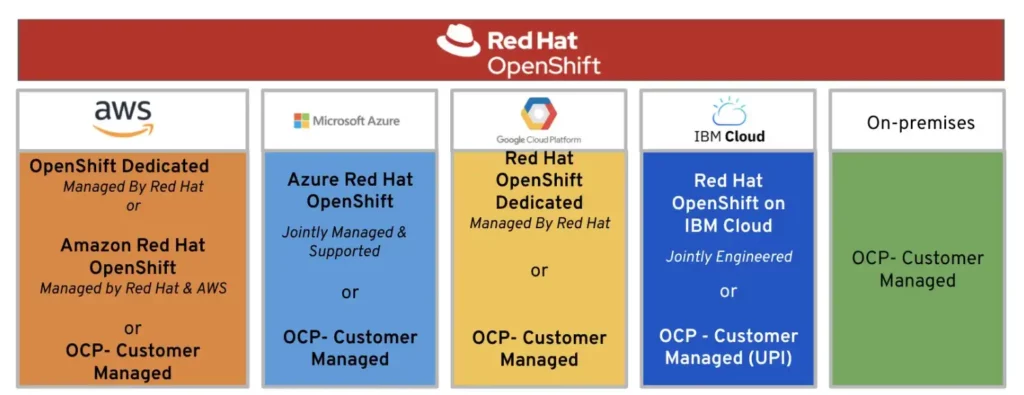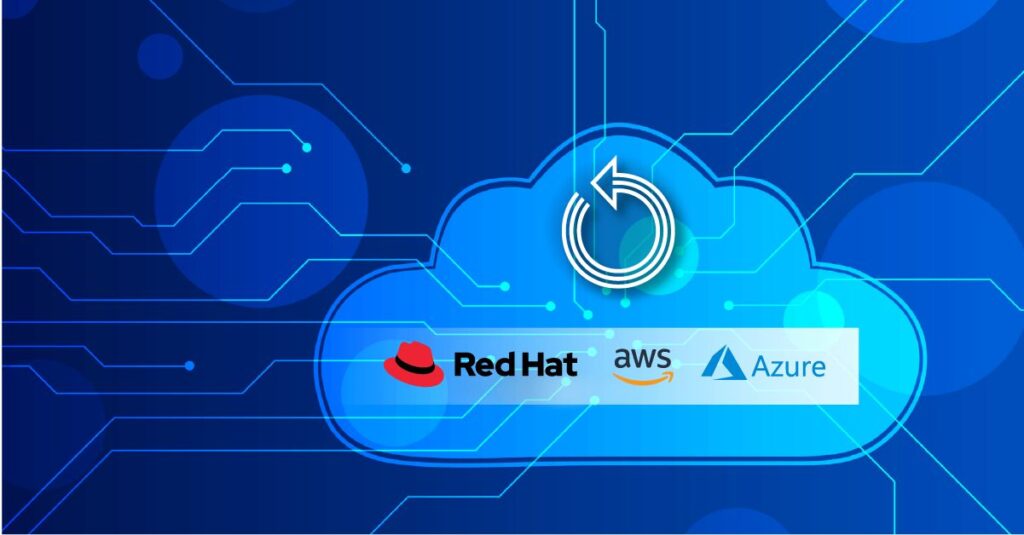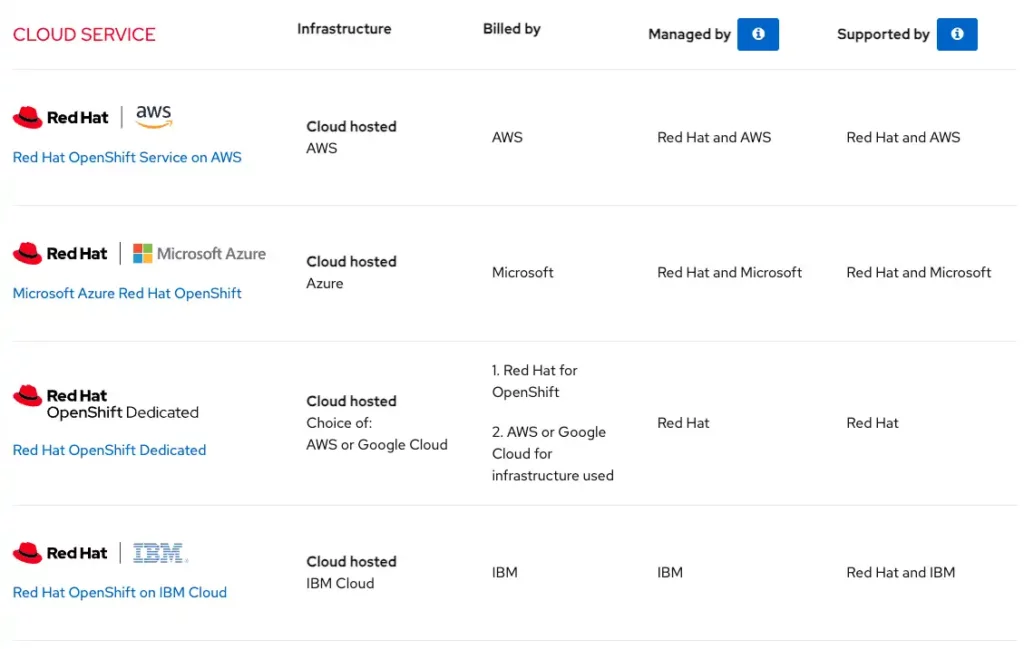Red Hat OpenShift Cloud Services: Enhancing Collaboration and Streamlining Software Delivery
DevOps is a set of practices that bring together software development (Dev) and IT operations (Ops) to foster collaboration and streamline the process of delivering software. In today’s world of software development DevOps plays a role in accelerating innovation, reducing time to market and enhancing customer satisfaction.
Microservices architecture is a style that organizes an application into independent and loosely coupled services. Each microservice focuses on business capabilities. Can be developed, deployed and scaled independently. This architecture promotes agility, scalability and resilience.
Red Hat OpenShift Cloud Services offers a platform that supports both DevOps practices while enabling the implementation of a microservices architecture.
Aiding DevOps Practices
With Red Hat OpenShift Cloud Services, developers and operations teams can seamlessly collaborate throughout the software development lifecycle. The platform provides built in tools. Features that facilitate automation, continuous integration and continuous delivery. This leads to more software releases.
- Automation: Red Hat OpenShift Cloud Services automates processes such as application building, testing and deployment. This minimizes manual errors while improving efficiency by ensuring repeatable deployments.
- Continuous Integration: The platform seamlessly integrates with CI/CD tools empowering developers to build, test and deploy their applications, with each code commit. This facilitates detection of any issues. Encourages frequent integration of code.
- Continuous Deployment: Red Hat OpenShift Cloud Services facilitates application deployment using deployment strategies such as rolling updates and blue green deployments. This ensures service and minimal disruption to end users during software updates.
Supporting Microservices
Red Hat OpenShift Cloud Services provides a foundation for the development and management of microservices based applications.
- Containerization: Using OpenShift for container orchestration, in the context of deploying and managing microservices is an effective approach. Containers provide isolation, flexibility and portability making them an ideal choice for building microservices architecture. Moreover by integrating Trilio into your OpenShift based microservices platform you can significantly enhance the data protection, and data management capabilities. This ensures the resilience of your containerized applications and their associated data.
- Service Mesh: Red Hat OpenShift Cloud Services incorporates a service mesh like Istio to effectively manage communication between microservices. This guarantees reliable and observable interactions within the application.
- Observability: The platform includes monitoring and observability features that enable teams to gain insights into the performance, health and behavior of their microservices. This proactive approach allows for issue detection and resolution.
Red Hat OpenShift Cloud Services enables organizations to adopt DevOps methodologies and take advantage of the advantages offered by microservices architecture. By automating procedures encouraging collaboration and offering a platform, Red Hat OpenShift Cloud Services speeds up software delivery and fosters creativity and innovation.
You can find more information about OpenShift Cloud Services here
Red Hat OpenShift Cloud Services: The Best of Both Worlds, for Hybrid Cloud and Infrastructure Automation
Hybrid cloud refers to a computing environment that combines private clouds allowing businesses to enjoy the advantages of both. By leveraging both types of cloud services organizations can easily expand their infrastructure while maintaining control over data.
One major benefit of cloud is its flexibility and agility. Businesses have the option to keep workloads and data on premises or in a cloud for compliance or security purposes while utilizing the scalability and cost effectiveness of public cloud resources for other applications.
Infrastructure as Code (IaC) is an approach to managing and provisioning infrastructure resources using machine definition files instead of manual configurations. This method enables organizations to automate and standardize the deployment process resulting in more reliable deployments.
Red Hat OpenShift Cloud Services is specifically designed to cater to cloud deployments and infrastructure automation needs. With its comprehensive platform organizations can seamlessly integrate their existing infrastructure with public cloud providers creating an environment that spans across clouds.
OpenShift Cloud Services, working hand in hand with Kubernetes and container solutions provides a Unified Application Platform. This platform empowers developers to consistently deploy and scale applications, in hybrid cloud environments.
It expands the capabilities of Kubernetes and containers to effectively handle workloads, across cloud infrastructures whether they are located on premises, in public clouds or a combination of both. Moreover the integration of Trilio for Kubernetes enhances the security and backup features ensuring that your applications remain resilient and recoverable across these cloud environments.
Furthermore, OpenShift Cloud Services supports automated infrastructure management by integrating with Infrastructure as Code tools like Ansible. This allows organizations to define their infrastructure resources, as code, and automate the provisioning and configuration of those resources. As a result deployments become faster. Operational costs decrease.

Red Hat OpenShift Cloud Services: Value and Solutions, for Businesses
Red Hat OpenShift Cloud Services offers an array of solutions and business benefits to companies of all sizes. Its comprehensive platform enables businesses to streamline operations, boost productivity and achieve scalability.
Explaining the Business Value
One of the advantages of Red Hat OpenShift Cloud Services is its ability to optimize development and deployment processes. By leveraging technologies like Kubernetes and containerization including Trilio for Kubernetes businesses can expedite application delivery while ensuring performance across various environments. This efficiency does not only lead to cost savings but also enhances data protection and backup capabilities promoting agile operations.
Moreover Red Hat OpenShift Cloud Services facilitates the implementation of a DevOps culture and supports microservices architecture adoption. This approach enables collaboration among teams, automated processes and faster application delivery to meet evolving customer demands. Consequently businesses can improve time to market. Gain an edge in their industry.
Red Hat OpenShift Cloud Services brings business value through its platform by optimizing operations fostering collaboration and achieving impressive scalability.
Red Hat OpenShift Cloud Services have proven to be highly effective, in driving innovation, cutting down expenses and empowering businesses to thrive in today’s market. This is evident through success stories and real world examples, across industries.
Increased Data Protection + Resiliency for OpenShift in the Cloud
Despite the many benefits of running OpenShift in AWS, IBM and Azure, or even OpenShift Dedicated, you still need a resiliency strategy to ensure that your apps are ready for the unexpected.
After all, built-in data protection via the cloud doesn’t provide the robust backup your cloud-native apps need to rebound quickly when disaster hits. And given the extensive cost of downtime, you can’t afford to risk incomplete coverage.
That’s why you need cloud-native data protection and management that scales with your OpenShift environment, no matter where it is. As a certified solution that’s tightly integrated with the Red Hat ecosystem, Trilio for OpenShift (T4K) fits the bill.
With T4K, your applications running on ROSA, ARO, IBM Clouds or OpenShift Dedicated —data, metadata, images, and all associated Kubernetes objects—are protected, quickly recoverable, and easy to migrate. And it’s simple to add T4K from the OpenShift OperatorHub. You can even use your AWS credits to purchase it from the AWS Marketplace, reducing the cost.
Benefits of Trilio for OpenShfit Cloud Services Users
Trilio for Kubernetes has some exclusive benefits just for ROSA, ARO and OpenShift Dedicated including:
-
- Native integration: T4K natively integrates with OpenShift and is compatible with Red Hat OpenShift Data Foundation (ODF) and AWS S3 storage, removing any extra configuration steps during setup. You can find and deploy T4K as a unified solution from the OpenShift OperatorHub, and ROSA users can subscribe to it from the AWS Marketplace.
- Easy deployment and management: T4K is deployed as a Kubernetes operator on OpenShift, ROSA, and ARO, providing a simple way to deploy and manage environments. All of these OpenShift options can be centrally managed through the T4K Management Console, which includes the ability to automate data protection and storage operations to boost your resiliency.
- Optimized for cost, performance, and security: If you run OpenShift alongside EKS or AKS, you can use T4K to migrate your applications seamlessly between services, helping you save costs and increase security and performance.
- Red Hat certified: T4K is Red Hat OpenShift Operator Certified, so compatibility is never a problem. T4K has also been vetted by AWS.
- Deployment & Purchase for OpenShift: OpenShift OperatorHub & Red Hat Marketplace
- Deployment and Purchase for EKS & ROSA: AWS Marketplace
- Listing for AKS and ARO: Azure Marketplace
In Conclusion
Incorporating Red Hat OpenShift into AWS, IBM or Azure Cloud environments offers benefits for organizations. It facilitates software delivery, collaboration, and the adoption of an efficient microservices architecture. Red Hat OpenShift achieves these advantages through the implementation of DevOps practices, automation, and integration with Infrastructure as Code.
However, to ensure the resiliency and safeguarding of critical data, Trilio steps in as a trusted ally. This solution seamlessly enhances data protection, ensuring that your cloud-native applications remain secure and easily recoverable.
The overall result is an approach to cloud-based operations. Red Hat OpenShift Cloud Services empowers businesses to optimize their operations, reduce costs, and accelerate the adoption of a DevOps culture. It provides an equipped platform that can effectively meet industry demands while enhancing competitiveness.
When combined with Trilio the application management experience is significantly improved. Whether on AWS using Red Hat OpenShift Service on AWS (ROSA) or Azure, with Azure Red Hat OpenShift (ARO), IBM Cloud or OpenShift Dedicated, businesses can expect a flexible ecosystem that caters to their needs while minimizing risks and fostering innovation.


